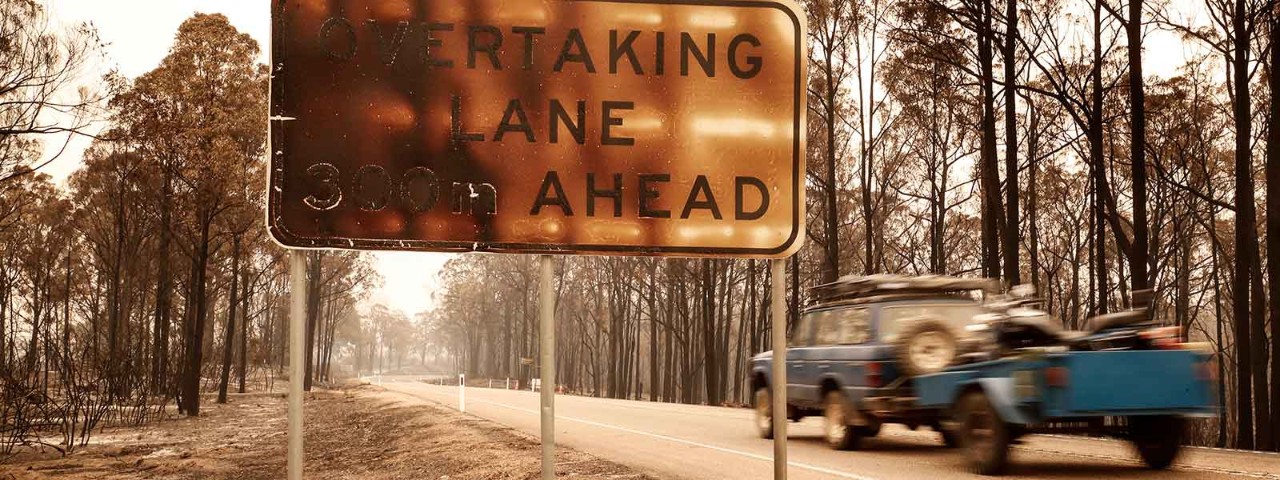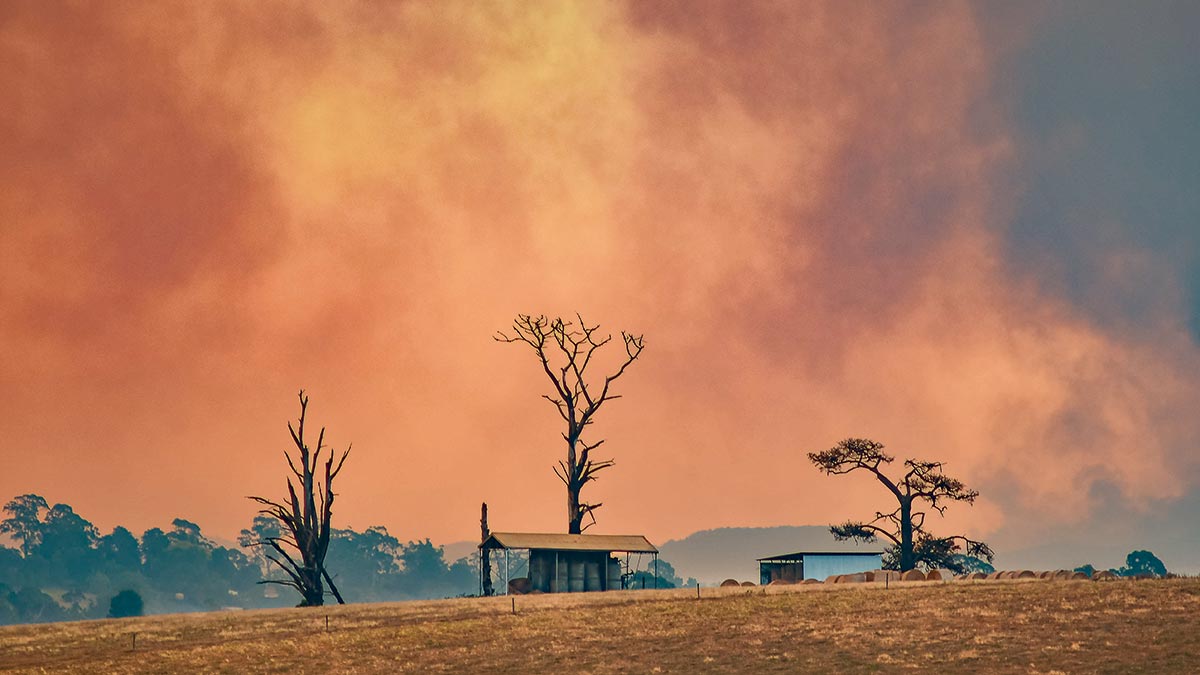After more than two years after the devastating Black Summer bushfires, RACV is continuing to help regional towns keep the lights on when they need it most.
When is it time to leave in the event of a bushfire? What if it’s too late?

Victoria is one of the most fire-prone areas in the world, and bushfires are just part of our lives – particularly for those living in regional and remote areas.
Deciding to abandon your property and possessions may seem like a tough decision, but it’s not. Nothing should be prioritised over the health and safety of yourself and your family.
Unfortunately, many residents and tourists delay their decision to leave for a myriad of reasons. All too often, bushfires and grassfires have been too intense or too fast-moving, and people have found themselves at serious risk of being killed or injured as a result of not having left sooner.
According to Michael Bourne, CFA Manager of Knowledge and Evidence, “recent CFA research by Ken Strahan and John Gilbert found that delaying leaving to relocate is less about indecision and more about people’s attitudes and responses to bushfire risks and how people make decisions.”
“CFA surveys have shown that around half of the households in the highest fire risk areas in Victoria describe the risk of bushfire at their home as only moderate, minor or no risk at all – even though they live in the extreme fire risk locations.”
“Even when households prepare bushfire plans, they are seldom written, rarely take account of possible or unexpected contingencies, and are rarely practised.”
Despite the La Nina weather event resulting in a cooler and wetter lead-up to summer than previous years, the bush and grasslands are drying out quickly, leaving Victorians and visitors at increasing risk.
Residents and visitors in regional Victoria need to stay informed about local bushfire warnings through any of the many CFA information channels available and the VicEmergency app and website.
When is it time to go?
According to CFA research, residents typically do one of three things when confronted with high-risk days and bushfires threatening their area:
Leave early
Whether it’s the night before or the morning of, prevention of a disaster is always preferable over managing the situation and having to make important decisions quickly.
“Leaving early is the safest option to protect yourself and your family and it means leaving the area before a fire starts – not when you can see flames or smell smoke,” says CFA Chief Officer Jason Heffernan.
While leaving early is the best choice, unfortunately, as many as one third of respondents to CFA surveys in bushfire-prone areas have said they would leave as soon as they were aware of a fire that could threaten their town. Less than one in 10 people plan to leave early on days of high fire danger.
Wait and see
As we have seen year after year, when driven by strong winds through dry vegetation, fires move quickly across the landscape and new fires can arise seemingly out of nowhere, and often ahead of the main fire front. These fires can be so intense that it is no longer safe to be in the area. But many people still ‘wait and see’ how a fire develops before deciding to leave.
“Deciding to ‘wait and see’ and having uncertainty about when to leave leads to late decision-making and late evacuation,” says Mr Bourne.
“This increases the likelihood of injuries – or worse – from being caught in the fire and on roads surrounded by smoke and flames and blocked by fallen trees.”
Many households have pets or other animals, such as horses and livestock, that they will need to plan and prepare for in the event of an emergency. If the decision to relocate is left too late, it can have dire consequences.
“Leaving early means it’s easier to make good, rational decisions and avoid panic, becoming trapped and risking serious injury or death. Waiting to leave means a drive that normally takes a few minutes could take hours, or you may not be able to get out at all,” says Chief Officer Heffernan.
Stay and defend
Many people’s properties are their livelihoods, and their possessions are priceless, so it’s understandable that some would want to defend their property from harm. However, in many cases, fighting mother nature is just simply not a fight that you can win.
As a fire grows in size and intensity, the ability to defend a property safely and successfully is dramatically reduced.
According to the CFA, there are three key factors that will determine an owner’s success when defending a property:
- The environment – there must be low fuel loads with grass and gardens well-tended, suitable vegetation, and structures designed and built to meet bushfire codes, with access to the right equipment, and no equipment failures on the day
- Fire behaviour – fires must remain at very low intensity for successful defence
- Human capabilities – very high physical and emotional strength is needed to meet the challenges ‘in the moment’ and to operate all the necessary equipment, with no injuries
“Any of these conditions can change rapidly during a fire – leading to serious injuries or worse,” says Mr Bourne.
Even if residents feel they can ‘stay and defend’ a property, everyone should know their ‘triggers’ for when to leave and have plans in place for their safe evacuation. Being able to leave safely depends on being prepared with your relocation kit, having somewhere safe to go, a safe route to travel, having arrangements in place for pets and animals, and getting out early.

Nothing should be prioritised over the health and safety of yourself and your family
Last resort survival tips
The very nature of bushfires makes them volatile and unpredictable, which is why leaving early is always the best option. However, there may come a situation where it is no longer safe to leave the area, and you will need to enact your backup plan.
If you cannot leave the general area, consider shelter options close by, including:
- a well-prepared home (yours or a neighbour’s) that you can actively defend
- a private bunker (that meets current regulations)
- a designated community shelter or refuge
It is important to understand that travelling to or sheltering in some of these locations does not guarantee your safety.
According to the CFA, if sheltering in a house or another building during a bushfire, it is imperative that you:
- Actively monitor and defend the house while inside during this time. Check for embers in the roof space and elsewhere in the house and extinguish them as quickly as possible
- Have a point of exit to the outside in every room used as a shelter. Do not shelter in the bathroom as it typically has only one door and a small window
- Remain alert and maintain visibility with the outside to know what is happening with the fire
- Keep hydrated
- If the house catches fire, move through the house away from the rooms on fire, closing doors behind you
- Plan an exit strategy for when the fire front has passed, or it is no longer safe to shelter in the house
- Move outside to burnt ground as soon as you can
While such places may provide a degree of safety, they do not offer solid protection from radiant heat or other dangers. They are likely to involve high-risk of physical and mental trauma, injury, or death.
You will need to protect yourself and your family from radiant heat by covering exposed skin with protective clothing, moving as far away from fire as possible and taking shelter behind a solid object or barrier.
Given the high likelihood of death or serious injury in such situations, it is critical that you understand the need to do everything possible to avoid having to use these last resort options.
Travellers, tourists, and road-trippers
Having spent much of the past two years in lockdown, it is understandable that people want to get out and explore their state during the holiday period. However, like the ferocity of a bushfire cannot be understated, having and applying the right knowledge is invaluable.
“Before you head off on holidays or to visit friends and family during the festive season and school holidays, download the VicEmergency app. Within the app, you can set up several watch zones for areas you will be staying in and travelling through, which will generate alerts for incidents in those areas,” says Chief Officer Heffernan.
“Make a plan for what you and your travelling party will do in case of an emergency, or weather/fire danger warning. Your plan should include things like which Fire Danger Rating will be your trigger to leave, where you will go, what route you will take. It should always contain different scenarios and back-up plans.”
The CFA website contains information about how to make a bushfire safety plans and preparing an emergency kit of vital things to bring when leaving early.
Tourism businesses also need to be ready for bushfires, and have effective evacuation plans to protect employees, customers, and their business.
